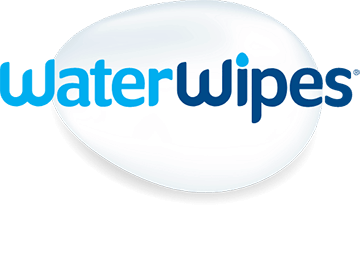Products
The baby aisle in the supermarket can be a daunting place for any parent with a number of different products which claim to be suitable for baby skin. Make sure you use skincare products on your little one designed for babies; such as fragrance-free lotions, wipes and bath gels. Be careful to check the ingredients they contain on the back of the pack. Many experts recommend you use plain water when washing your baby for the first 4 weeks or so. Did you know that WaterWipes is purer than cotton wool and cooled boiled water perfect for baby skin?
Newborn Skin
At birth, Your newborn baby may be born with a white coating on their skin known as vernix. This protects your baby’s skin. This coating will absorb naturally during the first few weeks. Newborn skin is also less firmly attached to other deeper layers of skin, so has a higher tendency to lose moisture. When youbathe your baby, the water and soap you use can cause the skin to dry out. With this in mind, keeping your baby’s skin moisturised is important.
Importance of keeping skin clean
Proper cleaning of your baby’s skin can help promote friendly bacteria, which is important in guarding against invading bacteria.
As your baby develops, they will begin to sit up, crawl and explore, but will also take an interest in trying different foods, likely to cause a bit of a mess! When cleaning your baby try to remove as much leftover milk, and food as well as snot and dribble, as possible. If these are left on the skin, it can cause irritation and skin rashes. Your child’s overall health also depends on keeping their skin free of harmful bacteria, found in urine and poo, which cause irritation and can lead to more harmful infections if transferred to the mouth.
Cleaning and caring for your baby’s skin
Babies’ skin needs to be looked after without inducing dryness or irritation, bathing them three times a week is enough to keep their skin clean. It is also fine to clean away dirt and bacteria with a wipe as bathing too frequently can remove the natural oils that protect a baby’s skin.
Make sure you focus on those hard-to-reach areas, and get into the folds of baby skin around the armpits, under their neck, knees, and legs, behind ears, toes, and genitals. As they grow and explore look for a water-based baby wipe product that is pure and gentle but effective at cleaning.
Did you know that 96% of Dermatologists agree that WaterWipes® is the #1 wipe choice for sensitive skin?
Nappy rash can happen so don’t panic
Nappy rash is something that most babies experience. The skin on your baby’s bottom is sensitive and delicate, so nappy rash is a normal part of life. It might seem obvious, but leaving a wet or dirty nappy on longer than necessary is the primary cause of nappy rash and irritation.
Always wash your hands before and after changing your baby’s nappy. Read all labels on lotions carefully. You can use a petroleum-based cream to protect against nappy rash. Look for hypoallergenic products that do not contain dyes or fragrances. You can also help baby’s skin by using only the purest ingredients, with the convenience of a wipe, an option like WaterWipes is an ideal sensitive baby wipe.
Keep an eye out for common skin rashes
A baby’s skin is prone to rashes of all sorts. From cradle cap, to baby acne, most baby-skin problems are harmless and go away on their own.
Cradle cap happens from a build-up of dry skin and natural oils on the scalp. This can cause a yellow crusty appearance on your baby’s scalp which is perfectly normal. When your baby is a few weeks old typically from around 6 weeks onwards, you can then use mild baby shampoo to help reduce the build-up of scales on the scalp when bathing.
Babies also often get eczema, which shows up as patches of red, dry and itchy skin on the face or behind the ears, and in the creases of the neck, knees and elbows. Make sure you regularly check your baby’s skin and if your baby has any rashes like eczema you can try washing your baby’s face with water and applying an unperfumed moisturiser to keep the skin moist.
Remember, if you are unsure or concerned about any markings you notice on your baby’s skin, or your baby has a persistent rash like baby eczema, visit your GP.

